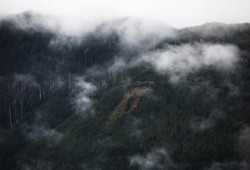Back in 1962, Herbert Jack began his career as a logger. His days consisted of attaching a cable to a felled tree before choking the log so it could be removed from the forest. The arduous work earned him $2 per hour.
Up to the 1990s, the logging industry on Vancouver Island thrived. Thousands of men just like Jack spent their lives tearing down trees for a living.
Back then, the 73-year-old recalls the majority of the trees were so wide a grown man couldn't wrap his arms around their trunks.
"They were big fellas – big fur like this," he said stretching his arms out wide.
By the time he retired in 2013, those 12-foot wide trees were a distant memory.
Now, the many of the valleys around Jack’s home in Kyuquot are devoid of old growth. Mount Paxton is still healing from being scrapped bare from top-to-bottom in the ‘80s: A poster child for the province’s logging practices.
Last summer, B.C.’s provincial government appointed an independent panel to consult with British Columbians about how to manage old-growth forests.
“We undertook the independent old growth strategic review because there was insufficient action on this topic by the previous government,” said a spokesperson from the B.C’s Ministry of Forests, Lands, Natural Resource Operations and Rural Development. “There is a need for stronger steps to protect biodiversity while still supporting workers and communities dependent on the forest resource. We are taking a science-based, thoughtful and serious approach.”
The ministry made the review public on Sept. 11, announcing the protection of nine old-growth regions around the province, including Clayoquot Sound.
But conservationists like Ken Wu, executive director of the Endangered Ecosystems Alliance, are quick to criticize.
“They had over three years,” said Wu of B.C.’s provincial government. “They’ll have gone through an entire electoral term with doing nothing and that’s a no-go for us. They’re going to be held accountable – absolutely accountable for that.”
In 2017, B.C.’s New Democratic Party’s environment platform referred to using the ecosystem-based management approach of the Great Bear Rainforest as a model in land-use planning and old-growth management.
That was an election platform promise they did not fulfill, said Wu.
The policy guidance for how much old growth to protect has remained “frozen in time,” said Kevin Kriese, chair of B.C.’s Forest Practices Board.
“What we really saw was an avoidance of facing that difficult set of decisions for about 15 years,” he said. “We’re very happy that there is a review – it’s overdue. I will also say that it is probably the most vexatious forest policy issue there is.”
Only 2.7 per cent of the original high productivity old-growth forests in B.C. remain, according to an independent scientific report titled, BC’s Old Growth Forest: A Last Stand for Biodiversity.
“These ecosystems are effectively the white rhino of old growth forests,” reads the report. “They are almost extinguished and will not recover from logging.”
Indigenous cultures evolved in old-growth forests. Dugout canoes, long houses and totem poles required old-growth red cedar.
“What we have left is probably the second grade of wood that our ancestors would have used,” said Tla-o-qui-aht First Nation master carver, Joe Martin.
B.C. is one of the last jurisdictions in the industrialized world to continue logging high productivity old-growth on a commercial scale.
“Most other places don’t have old growth left,” said Kriese. “They basically converted their natural forests to plantation forests a century before we did.”
The board chair predicts that we will be debating old growth logging “until the last stand of old-growth is logged in B.C.”
“It’s just that valuable,” he said.
Wu argues that establishing a more sustainable second-growth forestry would be a step in the right direction. Because it would be more labour intensive, it would require more people and ultimately, create more jobs.
“When you take the biggest, best and the most accessible first, you’re left with diminishing timber value,” he said. “Of course you’re going to lose a lot of the industry and a lot of the jobs – ecosystem collapses, employment collapses.”
The ministry said that it is committed to engaging with industry representatives on the report recommendations.
“Through those conversations we will be able to explore old-growth management approaches and how they relate to second-growth harvesting,” said the ministry spokesperson.
Kriese notes that public opinion is diverse, as not everyone is against old-growth logging.
“There are remote communities that rely on its employment and may not have very good other options, and yet there’s other options that may exist that we’re not exploring,” said the Forest Practices Board chair, stressing the importance of the province sharing decision making with First Nations. “It’s really critical that we actually pay attention to the issue and have a serious discussion – well-informed, science-informed, really good involvement of communities.”
For Jack, logging provided a way of life for him and his family. The self-described “old-timer” only made it to Grade 4 before getting kicked out of school for refusing to stop speaking his traditional language on Nootka Island.
With limited options available, he isn’t plagued with guilt when he looks back at the mountainsides he helped to cut down.
“I had to think of the family first,” he said. “Family comes first. They had to have a roof over them, clothing and [food] to eat.”








